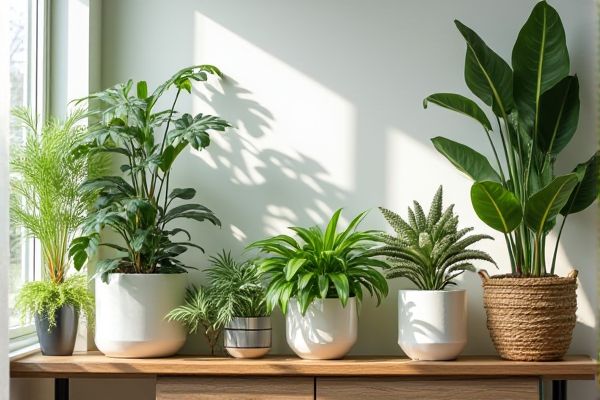
Artificial plants require minimal maintenance and remain vibrant year-round, making them ideal for busy lifestyles or low-light spaces. Discover the pros and cons of artificial plants versus live plants to decide which best suits your home or office environment. Read the full article to learn more.
Table of Comparison
| Feature | Artificial Plants | Live Plants |
|---|---|---|
| Maintenance | Low - no watering or pruning needed | High - requires watering, pruning, and care |
| Longevity | Durable - lasts years without wilting | Variable - dependent on care and species |
| Air Quality | None - no air purification benefits | Improves air quality - absorbs CO2 and releases oxygen |
| Appearance | Consistent - permanent color and shape | Dynamic - changes with seasons and health |
| Cost | One-time purchase, potentially higher upfront cost | Ongoing cost for care and replacement |
| Environmental Impact | Non-biodegradable materials, potential waste | Biodegradable, supports ecosystem |
| Allergens | Hypoallergenic - no pollen | May trigger allergies due to pollen or mold |
| Placement Flexibility | Can be placed anywhere, no light needed | Requires suitable light and environment |
Introduction to Artificial Plants vs Live Plants
Artificial plants offer a low-maintenance alternative to live plants, requiring no watering, sunlight, or pruning while maintaining a consistent aesthetic appeal. Live plants provide natural air purification, improve indoor humidity, and contribute to mental well-being through their organic presence and growth cycles. Choosing between artificial and live plants depends on factors such as maintenance capability, environmental impact, and the desired natural ambiance for a space.
Aesthetic Appeal: Realism and Variety
Artificial plants offer consistently vibrant colors and flawless shapes, maintaining their aesthetic appeal without the risk of wilting or seasonal changes, while live plants provide a natural, dynamic beauty that evolves over time with variations in growth and blooming cycles. High-quality artificial plants replicate the intricate details of real foliage, but live plants boast unique textures, scents, and organic variations that enhance sensory experiences and authenticity. The variety in live plants encompasses a wide range of species, sizes, and seasonal transformations, whereas artificial options excel in customizable designs and maintenance-free longevity.
Maintenance and Care Requirements
Artificial plants require minimal maintenance, needing only occasional dusting and cleaning, making them ideal for environments with low light or limited time for plant care. Live plants demand regular watering, pruning, and monitoring for pests and diseases to thrive, with specific care depending on the species and environmental conditions. The ongoing commitment for live plants supports air quality improvement and natural aesthetics, while artificial plants provide long-lasting decor without biological upkeep.
Longevity and Durability
Artificial plants offer exceptional longevity and durability, maintaining their appearance without wilting or requiring water and sunlight, making them ideal for low-maintenance decor. Live plants, while requiring consistent care, provide natural air purification and adapt to environmental changes but typically have a limited lifespan influenced by species and growing conditions. UV-resistant, fade-proof artificial plants withstand indoor and outdoor elements better than live plants, which are susceptible to pests, diseases, and seasonal variations.
Health and Air Quality Benefits
Live plants improve indoor air quality by absorbing carbon dioxide, releasing oxygen, and filtering harmful toxins, which enhances your overall health and well-being. Artificial plants do not provide these air-purifying benefits and can accumulate dust, potentially triggering allergies. Choosing live plants supports a healthier environment by naturally boosting oxygen levels and reducing airborne pollutants.
Environmental Impact and Sustainability
Artificial plants require petroleum-based materials and non-biodegradable components, contributing to long-term environmental waste, while live plants absorb CO2, improve air quality, and support biodiversity. Live plants promote sustainability by naturally recycling nutrients and reducing carbon footprints through oxygen production and habitat provision. Choosing live plants benefits your environment by fostering ecological balance and reducing plastic pollution.
Cost Comparison: Initial Investment and Long-Term Expenses
Artificial plants generally have a higher initial investment compared to live plants due to manufacturing and material quality, but they incur minimal long-term expenses as they require no watering, fertilizing, or pest control. Live plants may seem more affordable upfront but demand ongoing costs like soil, fertilizers, regular watering, and potential professional care to maintain their health and appearance. Your choice between artificial and live plants impacts both your immediate budget and future spending, with artificial options offering cost predictability and live plants providing natural benefits at variable long-term costs.
Versatility in Decor and Placement
Artificial plants offer unmatched versatility in decor and placement since they thrive in any environment without sunlight or water, making them ideal for dimly lit spaces, offices, and bathrooms. Live plants require specific light, humidity, and soil conditions, limiting their placement options but bringing natural air purification and growth benefits. Your choice between artificial and live plants depends on your need for low maintenance flexibility versus natural aesthetics and environmental impact.
Allergies and Pet Safety
Artificial plants eliminate the risk of triggering allergies since they do not produce pollen or harbor mold, making them ideal for allergy sufferers. Live plants can sometimes emit allergens and attract pests, posing potential health risks to both humans and pets. For pet safety, artificial plants avoid toxic reactions that certain live plants may cause if ingested by cats or dogs, providing a safer indoor environment for animals.
Making the Right Choice for Your Space
Choosing between artificial plants and live plants depends on factors such as maintenance, lighting, and air quality needs. Artificial plants require minimal upkeep and thrive in low-light environments, making them ideal for spaces with limited natural light or for individuals with allergies. Live plants improve air quality and provide natural aesthetic benefits but need regular watering, proper light, and care to thrive.
 homyna.com
homyna.com